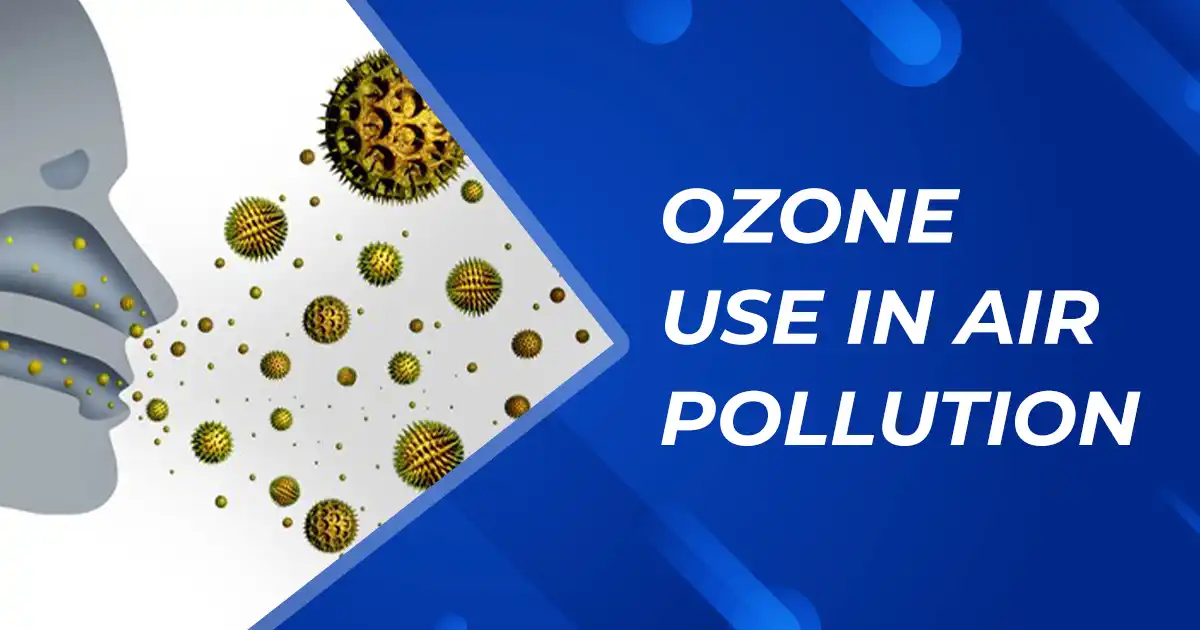OZONE USE IN AIR POLLUTION
Posted on: March 18, 2022
Ozone Use in Air Pollution
THE PROBLEM TODAY
There is growing awareness of the Health hazards of airborne microbes, such as moulds, fungi, bacteria and viruses found within indoor environment. Exposure to such microbes occurs in a variety of settings such as residences, office buildings, hospitals, airplanes, medical and dental offices. In addition, high levels of microbes can be found in most enclosed locations where people gather, such as schools, theatres, restaurants etc.
People spend approximately 90% of their time indoors. This increases their health risk more than out doors.
Medical research has linked Indoor Air Quality (IAQ) to numerous allergies, asthma, bronchitis, emphysema, heart disease and cancer. There are many less severe symptoms and diseases such as congestion, coughing, dermatitis, dry throat, headaches, eye irritation and viral infections that also reduce health, well being and quality of life.
Reduction in fresh air supply to most buildings in order to conserve air conditioning cooling costs have negative side effect of withholding the pollutants inside the building. This affects the health both in the short and long term of the occupants of these sick Buildings!!!
The conventional Systems and their Limited Use:
Conventional Air purification Technologies available today such as HEPA Filters, ionizing Lamps, Germicidal UV lamps and chemically treated filters offers incomplete solution in that they do not treat all the pollutants and that may be hazardous. Some merely transfer the micro organisms to a filter media, where they continue to live and multiply. When they eventually die, their decay can produce toxins and Endo-toxins that are reintroduced into the air. Technologies such as HEPA Filters are not suitable in places with limited air circulation as most of them depend on the recirculation of the air in the rooms. Others may just eliminate bacteria but do not remove harmful chemical pollutants. Still others just cover up the pollution with pleasant smells give a false sense of security of healthy environment. The well known “sick building syndrome” and Monday-itis in the western world is typically the result of foul air.
Air purification by OZONE
Ozone is nature’s own air purifier. It is created in nature by a flash of lighting during thunderstorm. This creates the freshness and invigoration of the environment.
OZONE is a unstable gas which is very active and has a characteristic penetrating odor, readily detectable at concentrations as low as 0.01 to 0.05 ppm and will change back to Oxygen quickly. OZONE immediately attacks the various odors and organic substances ( bacteria, virus, fungus and moulds ) and reduces them to harmless odorless compounds, The small amount of OZONE produced combines with the organic impurities in the air which will oxidise, neutralize and destroy the contaminates.
OZONE IS SAFE & MOST EFFECTIVE AIR- STERILISER
The USEPA recognizes Activated Oxygen (ozone)as an approved disinfectant process and is generally regarded as safe. OZONE also destroys bio aerosols ( micro organisms ), eliminates organic odors in addition to the destruction of VOCs ( Volatile Organic Compounds ) into harmless basic compounds. The Chart below compares the activity range of the various mechanisms use for controlling air pollution
A COMPARATIVE SUMMARY OF COMMERCIALLY AVAILABLE
AIR CLEANING TECHNOLOGIES
| Active
Carbon Filter |
HEPA
Filter |
Air
Ozonation |
Chemical/ Biocidal | High Energy
UV light |
Electrostatic
Filter |
|
| CAPTURES MICROORGANISMS | X | X | X | |||
| DESTROYS MICROORGANISMS | X | X | X | |||
| CREATES NO HAZARDOUS WASTE PRODUCTS | x | |||||
| GENERATES NO OZONE | X | X | X | |||
| CAPTURES HIGH MOLECULAR WEIGHT VOC’S | X | |||||
| CAPTURES LOW MOLECULAR WEIGHT VOC’S | X | X | ||||
| DESTROYS HIGH MOLECULAR WEIGHT VOC’S | X | X | ||||
| DESTROYS LOW MOLECULAR WEIGHT VOC’S | X | |||||
| UNLIMITED CAPACITY | X | X | X | |||
| ELIMINATES ORGANC ODORS | X | X | X | |||
| LOW PRESSURE DROP | X | X | X | X | ||
| LOW MAINTENANCE COST | X | X | ||||
| LOW OPERATING COST | X | X |
OZONE IN REFRIGERATION AND FOOD PRESERVATION
The American Society of Heating, Refrigerating and Air Conditioning (ASHRAE) cites benefits of ozone use in refrigerator, cold storage ware houses, restaurant refrigerators, supermarket refrigerator coolers, among other places, The following are the four of the successful and outstanding applications of Ozone.
- OZONE AND FRUIT AND VEGETABLES : – the largest use is of ozonation of fruits and vegetables. Ozone reduces the ripening process by destroying the ethylene produced during ripening which catalyses further ripening.
- OZONE AND MOULD: Ozone controls surface moulds on the packages and the walls and reduces scale development and decay. The presence of ozone significantly reduces the occurrences of moulds.
- OZONE AND MEAT: Outstanding use of Ozonation is in meat storage. Ozone in a cold storage is used to control the growth of mould and bacteria.
- OZONE AND EGGS: Ozone as supplement in the storage of eggs is used to prevent mold growth and decay of egg material both within and without the egg..
OZONE ATTACKS E-COLI- SALMONELLA-ASPERGILLUS-STREP & STAPH-CANDIDA ALBICANS AND A HOST OF OTHER MOULDS –BACTERIA-AND FOOD ODOURS.
OZONE USES IN ODOR CONTROL :
Most odoriferous (aromatic) substances are all organic compounds conjugated linkages which are easily attacked by ozone.
Ozone is particularly useful in odor control in the following areas:
- SMOKE ODOR REMOVAL – Hotel rooms after heavy smoking or parties, Cleaners, Painting and Decorating operations, new carpets,
- BUILDINGS: Air re-circulation systems, effectively stops algae, fungus and bacteria formation, saves maintenance expenses, cuts down the amount of air needed, saves fuel expense.
- APARTMENTS: Destroy food and other odors from various apartments, Kills odors of garbage rooms and deodorizes party rooms. Most effective in removing odors in all types of ventilated office and buildings
- BEAUTY PARLOURS: Destroys odors of hair sprays, nail polish, perms etc. Keeps air fresh
- SUPER MARKET STORES: To keep air fresh all the time. Ideal for meat preparation areas, meat and vegetable coolers, fresh fish areas
- DEPARTMENT STORES : Store smells nice and fresh when opened in the morning
- BANKS: Vault areas, storage areas, central ventilating areas.
- HOSPITALS: Chronic Care rooms ICU & ICCU, Cancer Rooms, Laundries, Food Preparation area, Garbage rooms, Operation theatres, and Wards etc
- FORENSIC CENTERS : Morgue rooms, autopsy rooms, Laboratory exhaust systems.
- PET HOSPITALS: Removal of stenches of animal excreta and odors.
- PROCESS AREAS: Remove odor from process areas especially in the Sea Food Industry Chemical factory, and to maintain sterile areas in Pharmaceutical Process areas, Electronic Industries, etc
ADVANTAGES of Ozone In Air Treatment
- Cleans and disinfects Air
- Biological Air Contaminants are destroyed
- Effective for microbes, Endo toxins VOCs and organic odors
- No toxic chemicals are employed
- Works well at room temperature
- Economical to operate and Easy to Install
- Smart looking and aesthetically designed
- Low maintenance costs, No replacement parts.( Except filters )
- 24 Hour timer devise to control Ozone levels in the Air
Indoor Air Pollutants
FACTS YOU MUST KNOW
Dust
Did you know? 42,000 dust mites can live in only one ounce of dust! Forty pounds of dust generated per year per 1,500 square feet of living space, will host 15 species of dust mites!
Bacteria
Did you Know? Bacteria are found in your heating and cooling system, house pets, garbage, bathroom-everywhere in your home!
Mold and Spores
Did you know? Mold spores are found in your heating and cooling system, in damp clothing, cleaning materials and the moisture in your ceilings, walls, carpets and drapes.
Heating and Cooling systems
Since it gathers dust and moisture, ductwork is a natural breeding ground for mold, mold spores, bacteria and dust mites. What’s worse, ductwork helps distribute these indoor air pollutants through your building.
Home cleaning products
Furniture polishes, ammonia and other cleaning products produce chemical vapors and harsh fumes.
Furnishings
That “new smell” from new carpeting, drapes, furniture and upholstery is actually chemical fumes, noxious gases and odors.
Construction Materials such as Paint, plywood and particle board (from cabinets, furniture, paneling) also emits chemical fumes, noxious gases and odors.
Clothing
Outdoor pollutants (pollens, oils, from smoke, gases, allergens and odors) attach themselves to our clothing. Once indoors, clothing releases these allergens, gases and odors into the air.
Tightly constructed buildings can’t breathe.
These days, buildings are constructed tightly to conserve energy. Very little outside air enters and little inside air can escape. This means indoor air is re-circulated. And indoor air pollutants keep building up.
The Author, V.Baratharaj, has nearly 30 years experience in Ozone and is the Chairman and Managing Director of Ozone Technologies and Systems India Pvt Limited, a Chennai based Company specializing in ozone applications .He can be contacted at otsilozone@gmail.com

Shreyas Baratharaj | Director
Sheryas Barathraj has over 15 years of experience in municipal and industrial ozone applications. He has worked on some of the world’s largest ozone installations, with key interests in advanced oxidation, chemical synthesis, pharmaceutical water systems, and municipal drinking water treatment. LinkedIn Bio ›



